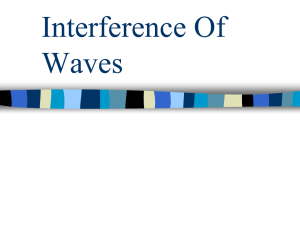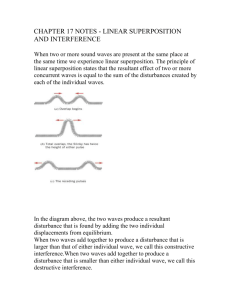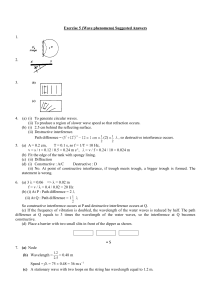Interference and Diffraction
advertisement
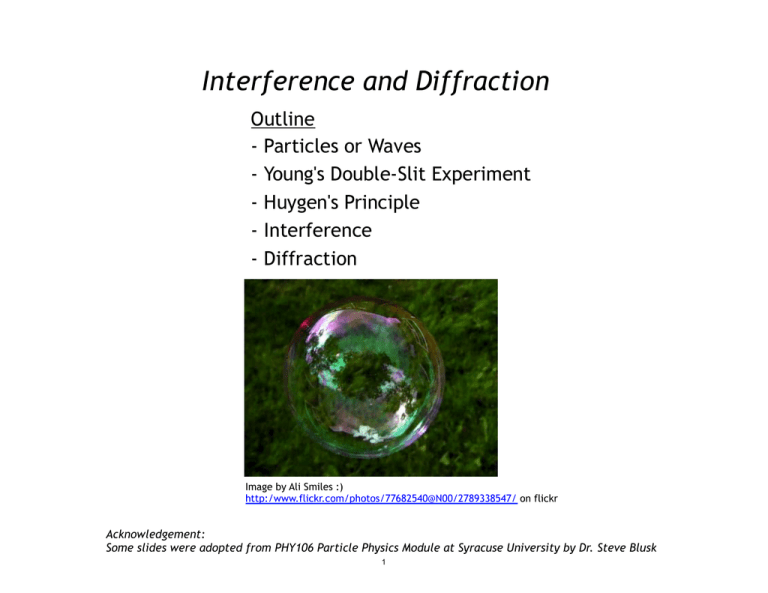
Interference and Diffraction Outline - Particles or Waves - Young's Double-Slit Experiment - Huygen's Principle - Interference - Diffraction Image by Ali Smiles :) http:/www.flickr.com/photos/77682540@N00/2789338547/ on flickr Acknowledgement: Some slides were adopted from PHY106 Particle Physics Module at Syracuse University by Dr. Steve Blusk 1 Are Photons Particles or Waves ? Newton believed that light was particles: • light travels in straight lines ! Particles result in straight shadows Image is in the public domain Image by Jeffrey Jose http://www.flickr.com/photos/jeffjosejeff/3380359510/ on flickr • what is waving in an EM wave ? A wave is a vibration of some medium through which it propagates, e.g., water waves, waves propagating on a string 2 Are Photons Particles or Waves ? Incident light Constructive interference air oil Image by May Wong http://www.flickr.com/photos/ maywong_photos/5569932571/ on flickr water Image by Yoko Nekonomania http://www. flickr.com/photos/nekonomania/4827035737/ on flickr Young’s Double Slit Experiment Light Propagation Direction Coherent Sunlight From Single Slit Constructive Interference Destructive Interference detector screen Waves bend to produce shadows Screen Image by Pieter Kuiper http://commons. wikimedia.org/wiki/File:Compact-Disc-spectrumMercury.jpg on wikimedia commons 3 Thomas Youngs Double Slit Experiment Propagation direction Coherent Sunlight From single slit Barrier with double slits destructive interference constructive interference detector screen 4 Historical Note: When Thomas Young published his result in 1802 he encountered a great deal of criticism from the proponents of Newtons particle theory of light. One objection was that the interference experiment was inconsistent with the law of energy conservation (at points of constructive interference, the light intensity is twice the intensity calculated by adding the intensities associated with each individual slit). - Is energy conservation violated ? Young was discouraged by the criticism of his work, and gave up his research in optics for other endeavors. (He made a major contribution to Egyptology by deciphering the Rosetta stone. His theory of color vision is widely cited today, so is his work on elasticity. He made pioneering contributions in studies of sound, tides, and human voice.) Thomas Youngs Double Slit Experiment Interference is the defining characteristic of waves ? Barrier With two slits detector screen Image is in the public domain 5 Huygenʼs Principle Huygen assumed that light is a form of wave motion rather than a stream of particles Huygenʼs Principle is a geometric construction for determining the position of a new wave at some point based on the knowledge of the wave front that preceded it All points on a given wave front are taken as point sources for the production of spherical secondary waves, called wavelets, which propagate in the forward direction with speeds characteristic of waves in that medium – After some time has elapsed, the new position of the wave front is the surface tangent to the wavelets As you might expect, the heuristic idea of Huygens can be fully justified through various derivations associated with the Maxwell equations. 6 Huygenʼs Construction for a Plane Wave At t = 0, the wave front is indicated by the plane AAʼ The points are representative sources for the wavelets After the wavelets have moved a distance cΔt, a new plane BBʼ can be drawn tangent to the wavefronts k cΔt old wavefront 7 new wavefront Huygenʼs Construction for a Spherical Wave The inner arc represents part of the spherical wave The points are representative points where wavelets are propagated cΔt old wavefront The new wavefront is tangent at each point to the wavelet new wavefront 8 Huygens Construction for a Reflection Incident wave λ θi (a) (c) θr (b) (d) 9 Huygensʼ Principle Explains Diffraction source 10 Applying Huygensʼ Principle to Two Slits Rays Screen S1 S2 11 Wave Interference λ + + CONSTRUCTIVE DESTRUCTIVE 12 Interference of Coherent Waves In the Double-Slit Experiment Dark (destructive interference) Bright (constructive interference) S1 Screen S1 d θ1 d S2 S2 L λ/2 L Bright (constructive interference) Waves at slits have to be coherent for interference to occur! Two different light bulbs in front of each slit will not give interference pattern. θ2 d λ 13 L Light Particles or Waves? Youngʼs Double-Slit Experiment! we expect to see the following patterns for … particles ? waves Barrier With two slits detector screen What should we see on the detector screen ? 14 Interference Preconditions 1. Light must be monochromatic, i.e., involve just a single frequency (single wavelength). 2. Light sources must be coherent, the relative phase is always the same. 3. Light sources must have the same amplitudes. If these conditions do not hold, one still gets constructive and destructive interference but the interference pattern can change with time or not be complete (destructive interference leads to a decrease in amplitude but not to zero amplitude). 15 Interference in Soap Bubbles Incident light path Constructive interference Incident light path reflected light paths Thin part of bubble Destructive interference reflected light paths Thick part of bubble Interference between coincident waves λ Amplitude A Amplitude B Increased Amplitude Image by Ali Smiles :) http:/www.flickr.com/photos/77682540@N00/2789338547/ on flickr Constructive interference 16 Decreased Amplitude Destructive interference Interference Fringes dsin(θ) = mλ, m = 0, ±1, ±2, ... dsin(θ) = (m + 1/2)λ, m = 0, ±1, ±2, ... Constructive Destructive m is the order of an interference fringe constructive interference m=3 2 2 1 0 1 3 l2 destructive interference l1 2 1 0 0 1 2 S1 3 S2 Image is in the public domain 17 θ θ l1 − l2 = dsin(θ) Interference Fringes dsin(θ) = mλ, m = 0, ±1, ±2, ... dsin(θ) = (m + 1/2)λ, m = 0, ±1, ±2, ... Constructive Destructive If distance d between slits is decreased, then the angles θ corresponding to the bright fringes will … (Choose one) 1. 2. 3. 4. all become smaller. all become larger some will become larger, some smaller. remain unchanged but the fringes will all become dimmer. 5. remain unchanged but the fringes will all become brighter. Animated image is in the public domain 18 Worked Example A screen contains two slits distance d = 0.100 mm apart and is length L = 1.20 m from a viewing screen. Monochromatic light of wavelength λ = 500 nm falls on the slits from a distant source. About how far apart Δx = x2-x1 will the bright interference fringes be on the screen? Answer: About 6 mm. Use small angle approximations to simplify algebra, avoid using sine and tan functions. S1 θ2 θ1 S2 19 x1 x2 Interference Fringes dsin(θ) = mλ, m = 0, ±1, ±2, ... dsin(θ) = (m + 1/2)λ, m = 0, ±1, ±2, ... Constructive Destructive If wavelength λ of monochromatic light impinging on two-slits experiment increases, then bright fringes … (Choose one) 1. all become closer. 2. all spread further apart. 3. some become closer, some further apart. 20 Diffraction of Light From Periodic Slit Source θ a θ asin(θ) = mλ One of world’s largest multilayer dielectric diffraction gratings Maxima in the intensity occur if this path length difference is an integer number of wavelengths. Double slit diffraction fringes with different slit separation Both images are in the public domain 21 Diffraction Pattern from a Single Slit The intensity pattern formed on a screen by diffraction from a single square aperture Numerical approximation of diffraction pattern from a slit of width four wavelengths with an incident plane wave. Both images are in the public domain 22 Key Takeaways In 1802 Thomas Youngs Double Slit Experiment demonstrated wave-nature of photons. (Much later, a similar double-slit experiment will be used to demonstrate wave nature of electrons, and of matter in general.) Huygens Principle is a geometric construction for determining the position of a new wave at some point based on the knowledge of the wave front that preceded it Image is in the public domain θ a θ asin(θ) = mλ dsin(θ) = mλ, dsin(θ) = (m + 1/2)λ, m = 0, ±1, ±2, ... Constructive m = 0, ±1, ±2, ... Destructive 23 MIT OpenCourseWare http://ocw.mit.edu 6.007 Electromagnetic Energy: From Motors to Lasers Spring 2011 For information about citing these materials or our Terms of Use, visit: http://ocw.mit.edu/terms.
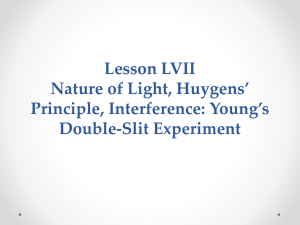

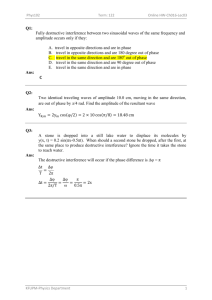
![Wave Interference []](http://s3.studylib.net/store/data/009269968_1-97379e48baef1370e4514f73f8b3c35d-300x300.png)

